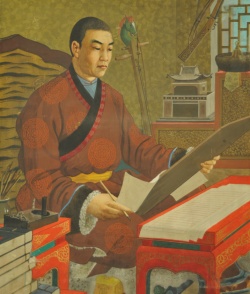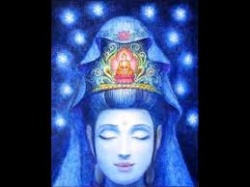Lion-dogs
The lion plays an important part in the decorative repertoire of Chinese Art. It not only occurs as a popular motif on carpets, but it is also frequently seen in designs on textiles and ceramics; painting and sculpture often have The lion as subject matter, while various other works of Art commonly incorporate it in their decorative patterns. The use of pictures to convey ideas through various types of Mental associations is one of the important traditions of Chinese Art. The image of The lion is considered a very auspicious Symbol and evokes a Wealth of associations.
The first mention of The lion in Chinese records is in the context of tribute from the king of the Yuezhi in 87 CE. For the Chinese its exact appearance was less
important than the qualities attributed to it: known to have come from the west as the most powerful and fearsome of all Animals, it made a deep and lasting impression on the Chinese imagination.The concept of lions as guardians against Evil may have been introduced to China as early as the late Zhou and the beginning of the Han period (206 BCE 220 CE). Most of the early lion representations that have survived are large funerary statuary, but some pottery examples in the Form of small crouching lions have been found in tombs of the third century CE in Jiangsu province and further south, fig. 2.
The forms and details of these Animals are closely related to those of the magnificent stone lions guarding tombs of the Six Dynasties period (220589) near present-day Nanjing. The numerous Six Dynasties guardian lions illustrate the popularity of the subject matter in Chinese funerary Art in the fifth and sixth centuries. However, with the Introduction of Buddhism into China towards the end of the Han dynasty, lions were portrayed in new contexts. In Buddhism The lion is known as the mount of the Bodhisattva of Wisdom, hence the association of The lion with sageness.
During the Tang dynasty a very important Phenomenon took place, that of borrowing Art motifs from architecture to decorate utensils, first in silver and then in other materials. Lions, hitherto mostly confined, in secular Art, to symbolic adornment of tombs, were now used as a decorative motif on vessels, imitating western models. In pottery, we see lions portrayed in new poses, fig. 7. The rather stiff conventional representations based on Buddhist sculptures were now being replaced by lively and Life-like portraits.
The roaring beast of earlier Times had also adopted some distinctive features of the Pekinese dog, and the so-called lion-dog became generally accepted as the guardian animal. The motif of lions chasing a brocaded ball or flaming pearl is occasionally seen on textiles of the tenth and eleventh centuries. It has been suggested that the arrangement of Animals in a circle, seemingly chasing one another, may have been created for practical reasons, so that the craftsman could adapt the composition in any complicated scheme he liked. Decorative schemes of this type are known from architectural ornament, and may have been a source of inspiration for the decorative arts. The lion-dog was also depicted on Ming dynasty textiles, fig. 13, although remarkably few examples have survived.
Especially from the Ming dynasty onwards, Symbols proliferate in the decorative arts. They seem to be used without special Order. While some of them may have lost their original meaning along the Way, others may have been given new interpretations. The playful creatures portrayed on the Ming and Qing dynasty carpets appear to have hardly anything in common with the powerful guardian lions of the west.
Their initial association with authority seems to have been replaced by their general decorative character. However, the original symbolic meaning somehow still persists. This is the Time when favourable meanings related to homophony began to develop. Today we only have to think of the 'lion dance' to realize that they are still considered to be Animals capable of warding off Evil.

